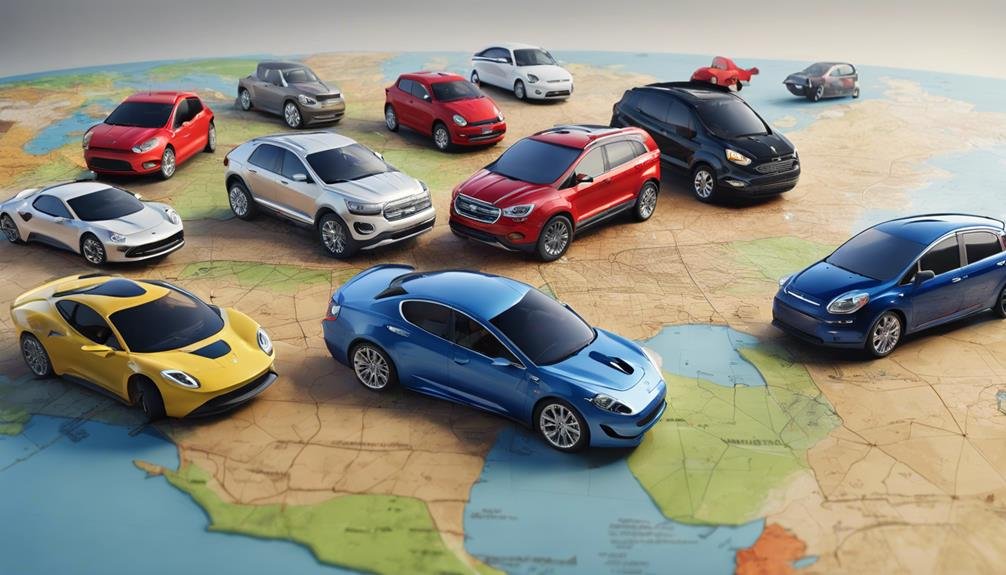Big Three Automakers: Definition, Companies, Market Cap and Share
The Big Three Automakers consist of General Motors Company (GM), Stellantis, and Ford Motor Company (F) with a combined market capitalization exceeding $200 billion. These industry leaders are known for pioneering automotive engineering, innovations, and a strong focus on sustainability and market diversification. General Motors, Ford, and Stellantis have market capitalizations of $91.8B, $85.7B, and $59B respectively. They face competition from Asian automakers and are strategically expanding globally while emphasizing hybrid and all-electric vehicle innovations. These companies are at the forefront of the automotive industry, adapting to market demands and investing in emerging technologies. Their impact on the global automotive industry is profound.
Key Takeaways
- Big Three Automakers are GM, Stellantis, and Ford with a combined market cap exceeding $200 billion.
- Market caps: GM $91.8B, Ford $85.7B, Stellantis $59B.
- Focus on sustainability, market expansion, and diversifying product offerings.
- Compete with Asian automakers like Toyota, Honda, Hyundai Kia Auto Group, and Nissan.
- Innovation strategies emphasize hybrid and all-electric vehicles for competitive advantage.
Big Three Automakers Overview
The Big Three Automakers, comprising General Motors Company (GM), Stellantis, and Ford Motor Company (F), collectively command a significant presence in the automotive industry with a combined market capitalization exceeding $200 billion. These industry giants are at the forefront of industry innovations and technology advancements, continuously working to push the boundaries of automotive engineering.
Importantly, sustainability initiatives are a key focus for the Big Three, as they seek to reduce their carbon footprint and embrace eco-friendly practices. Additionally, market expansion remains a priority, with efforts to tap into emerging markets and diversify their product offerings.
Through a strategic combination of cutting-edge technology, sustainable practices, and market expansion strategies, the Big Three Automakers continue to shape the automotive landscape globally.
Challenges and History
Pivoting from the focus on industry innovations and market expansion, the historical challenges faced by the Big Three Automakers have greatly shaped their trajectory in the automotive landscape. The Big Three encountered significant hurdles, including the 2009 financial crisis that led Chrysler and GM to file for bankruptcy and seek government bailouts.
Additionally, ongoing labor disputes, coupled with issues like poor management, have posed continuous challenges for General Motors, Stellantis, and Ford. These obstacles have influenced their operations, strategies, and relationships with stakeholders, emphasizing the importance of adaptability and resilience in the face of adversity.
Despite these challenges, the Big Three have demonstrated their ability to navigate turbulent times and remain key players in the global automotive industry.
Market Performance and Competition
In the face of fierce competition and evolving market dynamics, the Big Three Automakers display resilience and strategic adaptation in their pursuit of market performance excellence.
With market capitalizations of $91.8B, $85.7B, and $59B for General Motors, Ford, and Stellantis respectively as of Dec. 31, 2021, these companies are implementing global expansion strategies to maintain and grow their market share.
While Toyota led the global market share in 2020, the Big Three face stiff competition from Asian automakers like Toyota, Honda, Hyundai Kia Auto Group, and Nissan Motor Company.
To stay ahead, innovation strategies focusing on hybrid and all-electric vehicles are paramount as market trends shift towards eco-friendly options.
The ability of the Big Three to leverage global presence and innovate will be vital in maneuvering the competitive landscape.
Individual Company Profiles
Distinct in their operational strategies and market positioning, General Motors, Ford Motor Company, and Stellantis exhibit unique profiles within the automotive industry landscape.
General Motors is globally renowned for its technological advancements in electric vehicles, with a strong presence in multiple countries.
Ford Motor Company, as one of the oldest automakers in the U.S., not only offers a diverse vehicle lineup but also invests heavily in eco-friendly initiatives.
Stellantis, formed from the merger of Fiat Chrysler Automobiles and PSA Group, boasts well-known brands like Jeep and Dodge, operates on a global scale, and is at the forefront of investing in electric vehicle technology.
These companies are actively adapting to market demands by focusing on eco-friendly initiatives and technological advancements to stay competitive in the evolving automotive industry landscape.
Future Outlook and Industry Trends
Continuing to anticipate and adapt to evolving market forces, the future outlook for the Big Three automakers hinges greatly on their strategic investments in electric vehicle development and the shifting preferences of American consumers towards crossover vehicles and SUVs.
With a strong focus on the EV market trends, the Big Three are heavily investing in emerging technologies to compete with industry disruptors like Tesla. As governments mandate higher EV percentages, the regulatory environment is expected to drive the adoption of hybrid and all-electric vehicles.
Additionally, growth opportunities in emerging markets present potential for expansion. The success of the Big Three will depend on their ability to convince consumers to choose their EVs over competitors in the increasingly competitive automotive landscape.
Market Cap and Share Analysis
The comparative evaluation of market capitalization and share distribution among the Big Three automakers reveals essential insights into their competitive positioning within the automotive industry. As of Dec. 31, 2021, General Motors led with a market cap of $91.8B, followed by Ford at $85.7B, and Stellantis at $59B.
While General Motors has been advancing in electric vehicle technology, Ford is investing in eco-friendly initiatives and holds a significant share of the U.S. automotive market. Stellantis, formed from a recent merger, houses popular brands and is also focusing on electric vehicles.
Market trends indicate a shift towards hybrid and all-electric vehicles, impacting the market share distribution among automakers as consumer preferences align with the growing electric vehicle adoption.
Impact on Global Automotive Industry
The globalization of the automotive industry has greatly transformed market dynamics, leading to interconnected impacts on a global scale. Global market trends indicate a shift towards hybrid and all-electric vehicles, influencing market share and competition among automakers.
The Big Three face robust competition from Asian automakers like Toyota, Honda, and Hyundai Kia Auto Group, impacting their global market presence. Industry innovations, such as advancements in electric vehicle technology, are driving the future direction of the automotive sector.
As consumer preferences evolve towards crossover vehicles and SUVs, the Big Three are adapting their product offerings to meet these changing demands. Regulatory environments mandating higher EV percentages are also shaping the industry landscape, pushing automakers towards investing in eco-friendly initiatives and sustainable practices.
Conclusion
In the ever-evolving automotive landscape, the Big Three Automakers stand as formidable pillars of industry prowess, steering through challenges, and seizing opportunities with strategic precision.
As market leaders with a collective market capitalization exceeding $200 billion, General Motors, Stellantis, and Ford Motor Company continue to shape the global automotive narrative. Their historical significance, market performance, and adaptability to emerging trends underscore their enduring relevance in an industry defined by innovation and competition.
The future holds a landscape where these giants will continue to drive progress and shape the automotive world.







